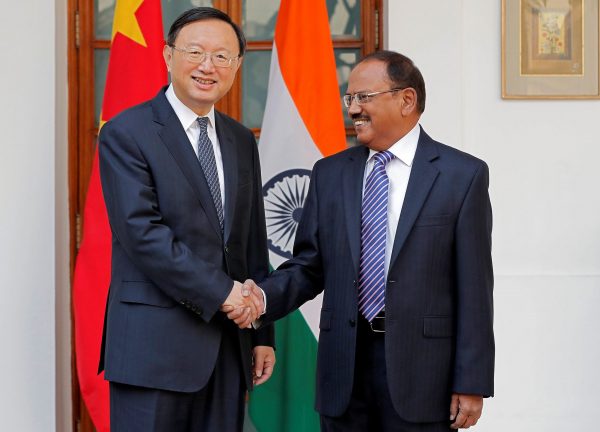The central issue was India’s increasingly uneasy relationship with China. There was a tense standoff between the two along their Himalayan border from June to August, as India moved troops into Doklam — a disputed area between China and Bhutan — to prevent Chinese construction crews from building a road that could be used to threaten India.
The situation was finally defused in advance of a meeting between Indian Prime Minister Narendra Modi and Chinese President Xi Jinping as part of the 9th BRICS summit in Xiamen, China. But the underlying differences remain unresolved and the ingredients exist for another crisis.
The Doklam crisis was the most dramatic instance of heightened tensions with China, but not the only one. Chinese proposals to establish land- and sea-based trade routes under its control as well as its overtures to India’s smaller island neighbours have led to Indian concerns about being encircled by China.
India boycotted the Belt and Road Forum held in Beijing in May, and has been trying to counter Chinese influence directly by establishing its own economic infrastructure projects in Southeast Asia, Iran and Central Asia. India has also attempted to counter Chinese influence by expanding military (especially naval) cooperation with the United States, Japan and Australia in a ‘quadrilateral dialogue’ or ‘quad’. Although there has been increasing cooperation with Japan on a host of fronts, the formalisation of this quadrilateral arrangement seems quite distant, possibly because of India’s own historical distrust of Western militaries.
The central question for Indian policy makers in these manoeuvrings was whether a strategic partnership with the United States in response to the expansion of Chinese influence would graduate from think tank proposals and newspaper editorials to actual policy. The signals remain mixed. In a state visit to Washington in June, Modi famously gave President Trump a hug on the White House steps, but the two leaders’ exchanging of pleasantries revealed quite different priorities. Where Modi spoke of shared strategic interests, Trump largely limited himself to touting export deals to which India had agreed.
Yet by November on a trip through Asia that included the 12th East Asia Summit in Manila, Trump repeatedly referred to the region as the ‘Indo-Pacific’ rather than the Asia Pacific in a move that was widely seen as a signal to India of its importance to US strategy. In conjunction with the revival of the quad at the same summit, Trump’s choice of language seemed significant.
Trump almost immediately appeared to contradict the central premise behind this relationship by embracing China as the preeminent power in the region. While it is tempting to see in this the President’s own unpredictability at work, the inconsistency also reflects the United States’ wide and conflicting strategic imperatives and the limited usefulness of India therein.
Modi still deserves credit for introducing a new dynamism into Indian foreign policy. On the economic front, by contrast, the government’s reform initiatives seem largely spent. 2016 saw the passage of a Goods and Services Tax, the demonetisation of large bills and a new bankruptcy law. But so far these reforms’ effects on growth have been muted or negative, resulting in the lowest growth rate in some years.
Despite this lacklustre economic performance, Modi’s Bharatiya Janata Party is winning state elections and looks poised to win a second term at the 2019 general elections. This partly reflects the disarray in the leading opposition party, the Indian National Congress. But it also marks the most worrisome trend in India during the Modi era: the growing use of religious violence by extremists in the majority Hindu community for political purposes, and with it the growth of a kind of mob coercion which India has never seen before.
The centrepiece of religious violence is the aggressive pursuit of ‘cow protection’ by right-wing groups varying from state governments to vigilante mobs who have been guilty of a steady stream of lynchings of Muslims accused of trading in beef. While Modi has condemned these actions he is generally seen as slow to respond and even slower to act against perpetrators who are largely supporters of his party. Meanwhile, liberal intellectuals charge that there has been an increase in ideologically motivated attacks on writers and journalists that the government simply ignores.
The last week of November saw two back-to-back visits by prominent Americans that highlighted the conflicting messages of Modi’s India in 2017. While President Trump’s daughter Ivanka spoke in glowing terms of India’s potential and its importance to the Trump administration at a conference in Hyderabad, former president Obama, attending another conference in Delhi, warned India about the dangers of alienating its Muslims. It remains to be seen whether either message will overpower the other in 2018.
Arun R Swamy is Associate Professor of Political Science at the University of Guam.
This article is part of an EAF special feature series on 2017 in review and the year ahead.

